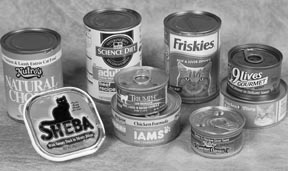The pop-zip of a can of food in the morning is enough to beckon the sleepiest feline.
According to the American Pet Products Manufacturers Association (APPMA), 30 percent of cat owners used canned food most often in 2000, down from 35 percent in 1998. APPMA said in its report, The decline in canned food may be associated with more cat owners now buying all natural/gourmet food, as documented by nine percent of the owners.
As with dry food, the first rule in selecting a canned food is that it should be complete and balanced, indicated through feeding trials by pet food manufacturers as stated in the Association of American Feed Control Officials (AAFCO) guidelines.
Helene Pazak, DVM, says that animals have requirements for nutrients, not ingredients.
Ingredients are combined to meet the animals protein, carbohydrate, fat, vitamin, and mineral needs, she says. [Whether its] the top five or human quality does not matter. Look for the complete and balanced statement and the AAFCO claim.
Ingredients to avoid, however, are ones to which an individual cat has shown a food intolerance or food allergy; it is very specific to the cat.

288
Feline sensitivities
Pazak, who is director of the Veterinary Technology Program at the College of Veterinary Medicine at Michigan State University, says that cats are very sensitive to shape and texture of food. They may like a single flavor of food but prefer the dinner form to the flaked version. And, they may eat different flavors of the same form. Veterinarians who treat anorexic felines have discovered its easier to entice those that like variety – different textures, forms, and flavors – to eat.
Concern is often expressed over po-tential dental problems in cats that are fed a mostly canned diet. Pazak, who is board certified by the American College of Veter-inary Nutrition, puts those concerns to rest.
One mode of therapy such as food cannot prevent dental disease, which also requires home dental hygiene care and professional cleaning as determined by the veterinarian. A cat eating only canned food and having an owner who brushes her teeth every day may actually have less dental disease than a cat eating all dry food and an owner who does not brush the animals teeth. Pazak notes that cats often swallow kibble whole. Because crunching the food makes it more effective as a dental aid, using the larger sized dental diets forces the cat to chew its food.
Canned cautions
Pazak advises cat owners who buy the large cans of food to cover and refrigerate the cans between uses to avoid potential bacterial growth. For the same reason and also to avoid losing moisture and palatability, canned food should not be left in the bowl for hours. Cats like food at body temperature, she says, recommending that refrigerated canned food be warmed in the microwave briefly, then stirred to mix in hot and cold spots.
While we like to equate price with quality, price generally reflects the cost of ingredients, processing, and packaging. But an owner may choose to pay the higher cost for food that carries an AAFCO feeding statement and that the cat likes. The true performance of a food is seen in the health and vigor of its consumer – your cat.



